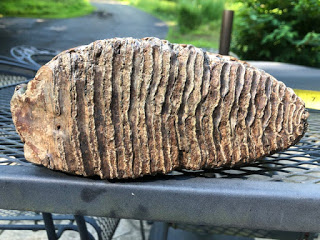AU Professor gains recognition for mammoth tooth found in Holmes
Dr. Nigel Brush holding one of his many findings
October 3, 2019
With the constant rains that took over Ohio this summer, this was the perfect time for archeologists to discover many fossils and artifacts that may surface. This was true for Ashland University professor, Dr. Nigel Brush.
Brush, professor of geology, traveled to the Inn Honey Run located in Holmes County to observe the streambed there. After a 12-year-old boy discovered a mammoth tooth on the stream bed at the hotel, Brush and his colleague Jeff Dilyard examined the area to find more.
Brush has been at AU since 1999 but has been conducting excavations as an archeologist for the past 38 years.
“After completing my course work for a Ph.D. in Anthropology at the University of California in Los Angeles, I returned to Ohio to conduct my dissertation research,” Brush said. During his dissertation, Brush surveyed over 200-square-miles of land and located 300 shelters used by Native Americans over a 13,000 year period.
He has worked with many students from not only AU but also the College of Wooster, Kent State University, University of Akron, Wayne College and The Ohio State University. Brush has also done work outside of North America by studying in England for a year and receiving his master’s degree in Archaeological Method and Theory from the University of Southampton.
“While at Southampton, I had the opportunity to work on a rescue excavation at Stonehenge,” Brush said.
With the recent recognition of the finding of the mammoth tooth, this brought back memories from another discovery Brush made.
Brush said that their most interesting discovery was a fire hearth beneath a rock shelter near the village of Layland in Coshocton County. A fire hearth is a stone-lined fireplace in which the first known settlers of North America, named Paleoindians, used as a source of heat.
The notoriety that came with the tooth was quite a shock to Brush.

The mammoth tooth that was found by a young boy in Holmes County.
“I was surprised that the story received so much local, national and international press coverage since I only spent about 15 seconds identifying the tooth as being from a mammoth,” Brush said.
He expresses this similar feeling when he and a group of archeologists discovered the Martin’s Creek Mammoth in 1993. “We spent many weeks working at this site before getting our 15 minutes of fame,” Brush said.
While Brush is the director of the Ashland/Wooster/Columbus Archaeological and Geologic Consortium, he has several recent projects completed. He and the Consortium donated 140 boxes full of artifacts, photos and records from the Killbuck Valley Rock Shelter Project. They are now located at Ohio History Connect Museum down in Columbus. With the research in Killbuck Valley, Brush is currently completing a book based around the project called “Rock Shelters of the Killbuck Valley: A 13,000-Year Record of Human Utilization.”
His passion for this field of science has garnered him recognition in state as well. The Ashland/Wooster/Columbus Archaeological and Geologic Consortium was awarded The Public Awareness award in 2016 for a 26 year-long project called the Walhonding Valley Late Prehistoric Sites Project.
“Archeology and geology gave me the chance to work outside,” Brush said. This has allowed him to continue to teach and to discover the history that lies beneath the Ohio lands.


